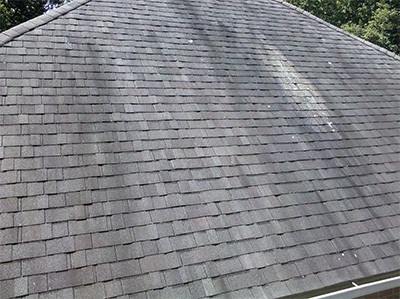
Algae growth usually begins on the north slopes and in other areas which receive little or no sunlight. These factors combined, allow for a great environment for this algae to grow. As algae grow on the roof, it retains even more moisture and thus speeds up the growth and discoloration process.
This photo shows another type of growth found on the same asphalt shingle roof. This mold or lichen is green in color and thrives in the same conditions.
What Is The Best Way To Eliminate Shingle Discoloration?
- Remove the existing shingles and reroof them with algae-resistant shingles. Most major manufacturers now offer algae-resistant shingles in most of their product lines.
- Apply a diluted chlorine bleach solution to the entire roof and rinse off. This works pretty well but should be left to a professional. Some companies now offer eco-friendly solutions that are less harmful to the environment. Ask us about our roof cleaning and rejuvenation services.
- Have a Z. ( zinc) strip installed at each side of the ridge. In time the chemical reaction between water and zinc will kill the algae. This solution works pretty well especially on low-slope roofs with gable ends. Higher-pitched roofs and roofs with numerous hips present a challenge best left to a professional roofing contractor. Call our team today and hire the best company in the are for this type of roofing repairs.

